Euro 100 banknotes are popular with citizens of Russia and neighboring countries who prefer to keep their savings in EU currency. But experts warn that counterfeit banknotes are often found among such money.
It is not difficult to distinguish genuine 100 euros from a fake if you know what security features and special signs banknotes issued by the European Central Bank (ECB) have.

- Design features of euro banknotes
- Why are 100 euro banknotes often counterfeited?
- Ways to determine the authenticity of a banknote
- According to outward appearances
- To the touch
- into the light
- Watermark
- Protective tape
- Holographic element
- Mosaic
- under a magnifying glass
- ultraviolet
- Bill checking detector
- IR tags
- The main signs of the authenticity of the banknote
- at an angle
- Serial number
- Where real and fake euros "go"
Design features of euro banknotes
Before checking 100 euros for authenticity, you need to figure out what the money of the European Union looks like.
Throughout the existence of the currency, the ECB has released 2 of its series:
- "2002";
- "Europe" (2013).
Money of both series circulate throughout the EU, in total there are 7 denominations of banknotes: 5, 10, 20, 50, 100, 200 and 500 €. Banknotes of each denomination differ in size and color (see table).
| Currency denomination | Main color | Size (mm) |
| 5 | Gray | 120x62 |
| 10 | red-orange | 127x67 |
| 20 | blue | 133x72 |
| 50 | Orange | 140x77 |
| 100 | green | 147x82 (old banknotes), 147x77 (new) |
| 200 | yellow-brown | 153x82 (old), 153x77 (new) |
| 500 | purple | 160x82 |
The banknote design reflects 7 European architectural styles that were typical for the historical development of the Eurozone countries:
- antiquity;
- romance;
- gothic;
- the Renaissance;
- baroque and rococo;
- industrial era;
- modern.
The front side of the banknotes is decorated with windows and gates, embodying cooperation and openness, and 12 EU stars, symbolizing the dynamic development and harmony of united Europe.
Bridges are drawn on the reverse side of euro banknotes of all denominations. They point to the freedom of European peoples to communicate with each other and with the rest of the world. There is also a map of Europe on this side.
The design of the money is complemented by the name of the currency printed on each banknote in 2 languages: Greek (EYRO) and Latin (EURO). The 100 and 200 € banknotes issued after 2019 have the name of the currency in Cyrillic.
Why are 100 euro banknotes often counterfeited?
Counterfeiters often counterfeit mid-denomination notes because they are constantly in circulation and easier to sell. If in the EU countries such banknotes include 10, 20 and 50 €, then in Russia the leaders among fakes are 50 and 100 €.
Read also: checking coins for authenticity
It is not difficult to explain the spread of fake European “hundreds” in our country, because people who keep money in foreign currency most often buy euros in multiples of 100.

Ways to determine the authenticity of a banknote
You don't have to go to the bank to check a suspicious banknote. Knowing what methods of protection the Europeans provided with their banknotes, it is possible at home to distinguish fake 100 € from genuine ones.
According to outward appearances
The €100 banknote features green designs of a doorway and a bridge, which are in line with Rococo and Baroque styles. The color of the banknote of the old sample is less saturated than the Europa series.
All drawings present on the euro must have clear and smooth lines. If the images are blurred or their contours are interrupted, then the authenticity of money should be doubted.
The genuine 100 € of both series bear:
- denomination;
- the name of the currency;
- 12 stars and the flag of the European Union;
- EBC abbreviation in 5 languages;
- signature of the President of the ECB;
- security hologram;
- serial number;
- year of issue.
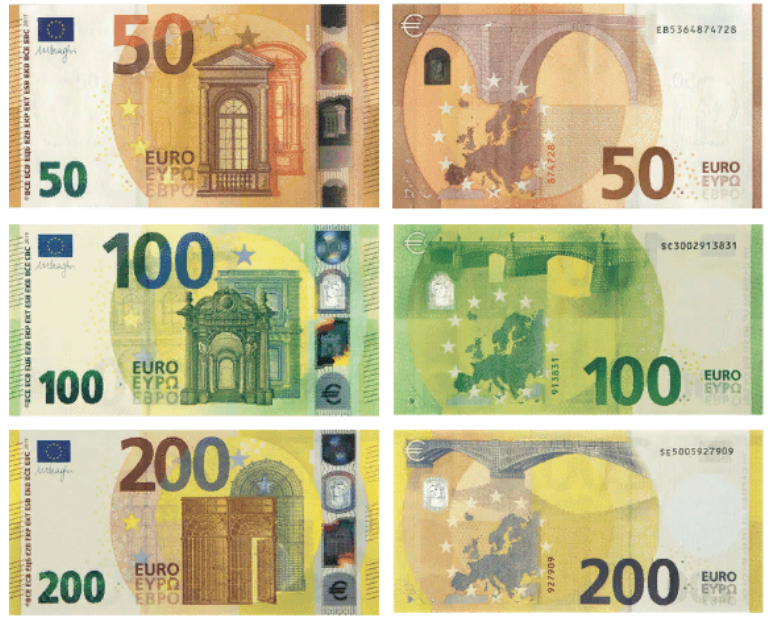
To the touch
To determine the authenticity of money, it is not enough to know how they look.
It will be possible to identify a fake with the help of tactile sensations, if the euro banknote is slightly wrinkled. Banknotes are printed on special money paper to make counterfeiting more difficult. The European banknote has a cotton base with the addition of impurities. This composition makes the banknotes strong and thin. Fake euros feel thicker to the touch than genuine ones.
Real euros will "sound" if they are crushed. We do not recommend damaging banknotes. Slightly bend the bill and hear a characteristic crunch. If you shake the euro, you will hear a ringing rustle. You won’t hear such a monetary melody from fakes, they are soft.
The paper on which the ECB issues money is made from pure cotton. It is dense and rough to the touch, crunches in the hands and bends well.
Due to a special type of printing, some elements of the image on the front side of the banknote have an increased relief, so that you can recognize the denomination, individual fragments of the doorway and a row with the ECB abbreviation by touch. The serial number is embossed on the back side.
If you have any doubts about the authenticity of the banknote, swipe the surface with your fingertips. Check:
- The abbreviation of the European Central Bank (ECB), written in several languages;
- Main drawing (windows or gates);
- Large denomination on the left side;
- Sign ©;
- Year of issue.
If you feel bulges, these are genuine banknotes.
The fake looks smooth.
into the light
When bringing a euro banknote to a light source, additional security elements should appear on it:
Watermark
It appears on both sides of the banknote, duplicating its denomination and the image of architectural structures. The banknote is unevenly dense. It is thinner where the watermarks are applied. Therefore, when checking, the bill is held against the light. The euro has three watermarks:
- repetition of the main image of the front side of the banknote;
- denomination;
- machine-readable barcode - rows of vertical dark and light stripes. The size of the stripes and the distance between them are individual for each denomination.
Read also: what does 500 rubles look like
There are many ways to simulate a watermark. The fake may not have a watermark. Such a banknote is not difficult to calculate.
But more often, counterfeiters overprint the watermark, i. print the image over the main pattern of the banknote. The print quality is different. You can easily figure out a low-quality fake. Remember: the watermark on a genuine banknote is visible from both sides: both from the front and from the back. Artful overprinting will be revealed by checking in a UV detector. Notice the black outline of the watermark? This is fake. In ultraviolet light, the watermark should not be visible.
Extremely dangerous are fakes in which a watermark is imprinted between two sheets. Such a fake will give out excessive contrast compared to the watermarks of genuine euros. Agree, with a cursory check, this difference is difficult to catch. Therefore, whenever possible, check the banknote in a complex way, using authenticity detectors.

Protective tape
Looking at a genuine bill in the light, it is easy to notice a dark vertical line running through the center. The security thread is metallized, so it has magnetic properties. After rubbing a genuine banknote against any magnetic sensor, you will hear a beep. At the moment, no imitations of the magnetic properties of the security thread have been found.
Magnetic inks are also used when applying the right side of the main face design and the top serial number on the back of the note.
On fake euros, magnetic protection is often absent.
A microtext is applied to the protective tape, consisting of the inscription 100 EURO in the upright and inverted position. There must be an entry on the magnetic tape corresponding to the denomination of the 100 euro banknote.

Holographic element
It is located on the front side of the banknote and shimmers with all shades of the rainbow.

Depending on the angle at which the light falls on 100 euros, the pattern on the hologram changes: either the denomination or the image of the window appears on it. Counterfeit banknotes also have a hologram, but it is dull and without a visual effect.

Mosaic
In the upper left corner are fragments of the banknote denomination. Take a close look at the upper left corner of the banknote on both sides. You will see the denomination of the banknote with obvious gaps. Now look at the banknote against the light. Parts connect in a figure. This is a composite image technology.
Counterfeiters reproduce it with distortions. Remember: the denomination lines must match without offsets and breaks!
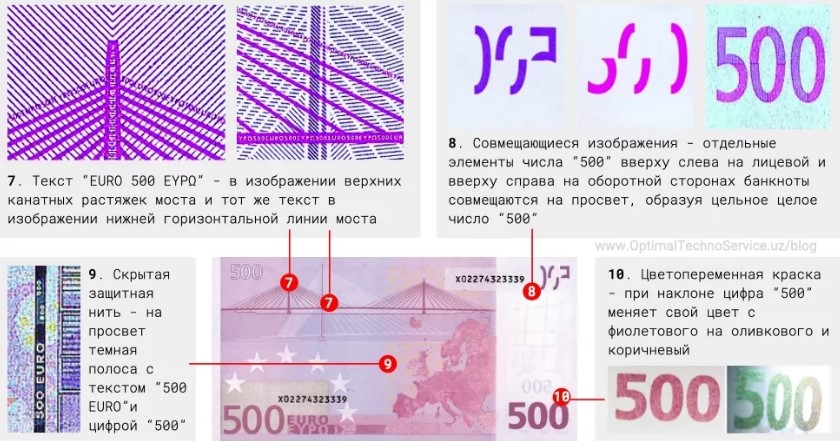
under a magnifying glass
The €100 banknote has a microtext that can be viewed under a 10x magnifying glass. It is found on the word EYRO (the Greek name for the currency) and the image of architectural structures.
Over the protective tape on the light is visible microtext - the word "EURO" and the denomination of the banknote. This is not the only microtext found on the euro. For example, on the front side of each banknote inside the text "EURO ΕΥΡΩ", rows of numbers denoting the denomination are printed diagonally. Each microtext has a certain place depending on the denomination of the bill.
Study microtexts carefully. Letters and numbers should stand out sharply and clearly. It is difficult to forge a microfont. On counterfeit banknotes, the letters appear smudged and blurry.
European banknotes are protected by micro-images - polygons and grids with ultra-fine edges. Like microtext, they are viewed at a large approximation.
Parts of a banknote with a micro-pattern have anti-scanner properties: when scanning a genuine banknote, a distorted image is obtained. Experts call this effect "moiré".

ultraviolet
If possible, the suspicious bill should be tested under ultraviolet light. The main difference between paper for banknotes and ordinary paper is the absence of a background glow in the ultraviolet.
Look at the original banknote. She looks black. Now check the paper. In ultraviolet light, it glows bright blue. Ultraviolet is not easy to fake. An attentive eye will immediately notice a false light, even if they tried to muffle it with special reagents.
Colorless fibers are embedded in the paper. Their glow is visible only in ultraviolet light. You will immediately notice red, blue and green hairs. Pay special attention to checking the fibers. When trying to reproduce protective fibers, a modern analogue of phosphorus is used - a phosphor. Don't rely on one-step verification. Check out other defensive signs of the euro.
In ultraviolet light, paper for euros should not glow, but colorless fibers, on the contrary, will appear. But these are not all the changes that will appear in ultraviolet light:
- The blue flag of the European Union, located in the upper left corner of the euro banknote, has become green.
- Blue, green and red fibrous particles appeared on the bill, which cannot be seen with the naked eye.
- The color of the EBU President's signature will change to green.
- On the front side, on the right side, where the doorway is drawn, 12 stars of the European Union became visible. Their brightness gradually decreases: if the first star can be clearly seen, then the last one is almost invisible.
- Glowing lines appeared next to the stars.
- And on the right and left sides, the drawings must fully match.
- The drawing of the bridge and the outline of the map of Europe on the back side turn green.
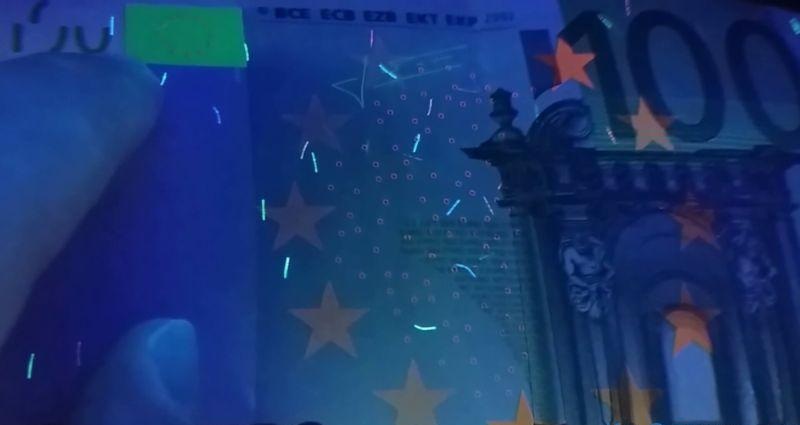
When checking the euro, keep in mind that light green paint is counterfeited more often.
Bill checking detector
A reliable way to make sure that a banknote is not counterfeit is to shine it on a detector that bank employees use to check money.
Most of the images on the front side of the euro are printed with IR metameric inks. Their peculiarity lies in the inability to reflect infrared rays. If the bill is genuine, then when placed in the detector, its left side will become invisible.

IR tags
In the infrared spectrum, the banknote will appear white, except for those elements that are applied with a special paint. They are called IR tags. We have already tested the same elements for magnetic properties:
- the right side of the main image;
- hologram;
- top serial number;
- denomination numbers on the back;
- security thread.
Didn't find these signs of authenticity? Euros are fake.
IR protection is by far the most reliable. Checking the euro for authenticity necessarily includes a check in the IR detector.
The main signs of the authenticity of the banknote
In addition to the signs listed above, the following methods will help to distinguish genuine 100 euros from fakes:
at an angle
Look at the digital designation from a different angle. On the back of old-style banknotes, it is colored purple. When you turn the bill, the numbers turn black. For 100 € of the new sample, the visual effect can be seen if you look at the denomination indicated on the lower left side of the front side.
At a right angle, the number 100 looks green, at an angle it looks blue. The change in color display can be achieved through the use of a special iridescent paint, which is difficult to fake.
It is very problematic to make iridescent paint, so this aspect should be paid attention first of all.
On the front of the banknotes of high denominations (€50, €100, €200 and €500) there is a hologram. With a change in the position of the bill, the pattern on the hologram also changes. Look closely and notice how the denomination numbers turn into windows (or gates). This is an extremely difficult defense to simulate. By its execution, it is easy to establish the authenticity of the euro.
Against the light, microscopic holes stand out on the hologram, forming the “€” symbol. This is another protective feature - microperforation. The holes are laser cut, so you can't feel them by touch.
The denomination and the word "EURO ΕΥΡΩ" are printed on the hologram in the smallest of microfonts. Counterfeiters reproduce it with a gross violation of microprinting. Note that high quality hologram fakes (except for €200) have not yet been found.

Serial number
Check the serial number of the banknote located on its back side. It consists of a letter of the Latin alphabet and 11 digits.
On EU money, the size of the letter is always smaller than the number.

Summing up all the numbers on the identifier of the euro banknote, and then adding to the result the serial number of the letter in the alphabet - if 100 euros are genuine, issued by the ECB, then it should be 8. Take the number S13136902855 as an example. Adding all the numbers, we get 43 (1 + 3 + 1 + 3 + 6 + 9 + 0 + 2 + 8 + 5 + 5 = 43).
Each letter has a corresponding code - check digit. For a genuine banknote, the sum of the digits of the serial number and the check digit are the same. After that, we add to the result the serial number of the letter S, equal to 19: 43 + 19 = 62. We sum up 6 and 2, we get 8. This figure indicates the authenticity of the bill.
| Serial number letters in the alphabet | Letter code | The country | Check Digit |
| 4 | D | Estonia | 4 |
| 5 | E | Slovakia | 3 |
| 6 | F | Malta | 2 |
| 7 | G | Cyprus | 1 |
| 8 | H | Slovenia | 9 |
| 10 | J | Great Britain | 7 |
| 11 | K | Sweden | 6 |
| 12 | L | Finland | 5 |
| 13 | M | Portugal | 4 |
| 14 | N | Austria | 3 |
| 16 | P | Netherlands | 1 |
| 18 | R | Luxembourg | 8 |
| 19 | S | Italy | 7 |
| 20 | T | Ireland | 6 |
| 21 | U | France | 5 |
| 22 | V | Spain | 4 |
| 23 | W | Denmark | 3 |
| 24 | X | Germany | 2 |
| 25 | Y | Greece | 1 |
| 26 | Z | Belgium | 9 |
There are many ways to distinguish 100 euros from a fake. But no matter what security methods money is equipped with, counterfeiters are constantly improving their skills and finding new opportunities to counterfeit banknotes.
In order not to become the owner of counterfeit currency, you should purchase it only at the bank. People who buy euros with their hands run the risk of running into a fake.

Where real and fake euros "go"
Since the main circulation of the euro is carried out in the EU countries, it is possible to meet the cash currency of this banknote not only in Europe, but also in the countries of the Middle East, and in almost all popular world resorts. This currency is considered the most secure against counterfeiting, which, however, does not stop counterfeiters. Is that these banknotes are much less likely to be counterfeited than the national currency and US dollars.
Counterfeit banknotes come to Russia mainly with tourists. And despite the fact that in our country the euro is not used for cash payments, many people prefer to keep their savings at home in this particular currency.

Among the fakes, the most common are paper banknotes of 10, 20 and 50 euros, as well as coins of 2 euros.
It is better not to deal with the latter at all, since it is extremely difficult to distinguish a fake from the original and, as a rule, it is impossible without special equipment.
So, let's sum up.
This euro banknote is fake if...
- It is thicker than other banknotes of the same denomination.
- It is too smooth, and the relief is not felt by the fingers.
- It does not rustle with sudden movements.
- Transfusion of holograms is not iridescent or non-existent.
- It does not have magnetic protection or it is distorted.
- Instead of a security thread and fibers, printed elements are visible.
- The star circle is brighter under ultraviolet lamp.
- The fibers and the flag do not glow under ultraviolet light.
Where to go if you sold a fake?
Discover!



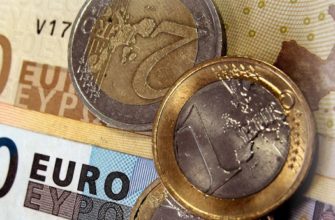

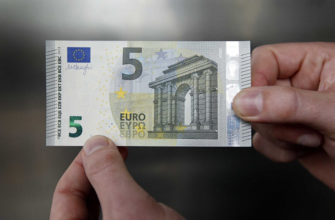

-335x220.jpg)







I didn't even know how interesting money really is. architecture can be studied, bulges, invisibility in the detector… is all money so unusual? we use them without thinking how much meaning the author puts into the symbols. well, it's a lyric. The article is so excitingly written that you remember the information involuntarily. author write textbooks for our children!
First, you immediately need to compare banknotes with each other. If you have 100 or 50 euros in advance, then you can carefully look at both. (if you have a banknote with you in advance). Secondly, you need to look at the light on the protective tape. There should be an inscription 100 or 50 euros on both sides. These ribbons are available in all banknotes in many countries. Or ask the cashier for another bill to compare them. If you do not believe in yourself, then you can ask for help from a nearby person.
I liked the video, which shows the glow of the banknote in the ultraviolet. This is an author's video, good quality with explanations. Wonderful!
It has always been interesting what the cashiers see on the bill when they bring it to the ultraviolet detector. The video in this article satisfied my curiosity completely! Everything is clearly visible.
To reduce the risk of getting a counterfeit banknote, I buy cash currency only in banks. Both in Russia and abroad. And I never buy it. Even close relatives. Haven't seen any fakes yet.
I’m going to work in Germany, I went to the article in order to be able to distinguish the euro from a fake, since in Germany the currency is the euro, I don’t want to be deceived and therefore decided to play it safe, took into account all the points, thank you.